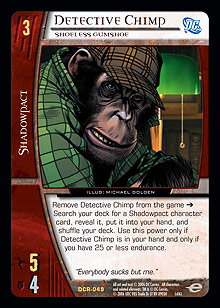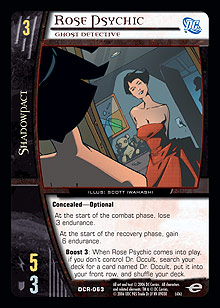Infinite Crisis was the tenth Vs. System set to be released. At the time, the game was over two years old. The idea of a Modern Age had been around for over a year, and Silver Age would make its debut a couple months later at Pro Circuit San Francisco. Ahmed Samsarra was to be the big splash, taking over the Top 8 of San Francisco and making possible the Deep Green deck that eventually took the title there. Ahmed also featured in the Checkmate / Villains United deck that TAWC played, earning Tim Batow a Top 8 slot.
But that was Silver Age, which at the time excluded Marvel Origins and DC Origins. No one really expected Infinite Crisis to make a splash in Golden Age. Golden was where the wild things were—Dr. Doom, Diabolic Genius and Roy Harper ◊ Arsenal, Sharpshooter, to name two. The extra ammunition these two sets brought to the format were expected to be just too much for any single new set to handle.
 Among the platinum hits of Ahmed and company was a lesser-known team: Shadowpact. The ’Pact had one of those unusual but fascinating team themes where something that’s generally considered a drawback is used as an advantage—in this case, your own endurance total. The closer you were to losing the game, the more control you would have over it. Cards like Detective Chimp, Shoeless Gumshoe gave you benefits when you were below 25 endurance, and June Moon ◊ Enchantress, Bad Witch granted more power if you were below 10.
Among the platinum hits of Ahmed and company was a lesser-known team: Shadowpact. The ’Pact had one of those unusual but fascinating team themes where something that’s generally considered a drawback is used as an advantage—in this case, your own endurance total. The closer you were to losing the game, the more control you would have over it. Cards like Detective Chimp, Shoeless Gumshoe gave you benefits when you were below 25 endurance, and June Moon ◊ Enchantress, Bad Witch granted more power if you were below 10.
In exchange for this supposed drawback, some of the best control cards in Vs. System history were re-imagined for their team. The Conclave, a shout-out to the Gotham Knights’ Fizzle, was given to Shadowpact with the “disadvantage” of costing you 4 endurance. Flame Trap was renamed Spectral Slaughter and gifted to the ’Pact, as well. June Moon ◊ Enchantress, Good Witch was Terra, Tara Markov without that pesky location requirement.
Not only that, but Shadowpact also got the ultimate gift: an extra resource point. Conjuration gave you that point at the cost of 15 endurance, which was usually just enough to let Detective Chimp, Shoeless Gumshoe search for the drop you wanted to make. How convenient.
The focus of the team seemed to be a curve deck with the best board control the game could offer. Madame Xanadu could fetch from your deck any card you might need, and Shazam dropped into play on turn 7 to seal the deal.
All these gifts came with a steep price. After about turn 5, you were continually living on the edge. You couldn’t really afford to get two characters stunned in the late game, as that could potentially kill you. You had to be very careful with your endurance total in the last few turns of the match—so much so that many players wrote off Shadowpact and turned to the aforementioned and easier-to-protect Ahmed Samsarra.
Not Bobby Rana.
Bobby actually elected to build and play the deck that seemed so obvious, and with a couple tweaks, he took it to the Top 4 in the city of Brisbane. His list:
Bobby Rana
Shadowpact
Characters
4 Ape X, Xina
4 Madame Xanadu
 4 Detective Chimp, Shoeless Gumshoe
4 Detective Chimp, Shoeless Gumshoe
4 Rose Psychic
4 June Moon ◊ Enchantress, Good Witch
2 Witchfire
1 Dr. Occult
1 Nightmaster, Demon Slayer
1 Dr. Fate, Hector Hall
1 Shazam
Plot Twists
4 Total Anarchy
3 Divination
3 Secret Origins
2 The Conclave
2 Conjuration
1 Absolute Dominance
1 Fate Has Spoken
1 Spectral Slaughter
Locations
4 Chimp Detective Agency
4 Dr. Fate’s Tower
1 The Oblivion Bar
Equipment
3 Amulet of Nabu
3 Helm of Nabu
2 Cloak of Nabu
Shadowpact is one of the most curve-centric teams in recent memory. From their low-drop hate in Spectral Slaughter to Conjuration, which helps big on-curve drops a lot more than it helps a weenie strategy, almost everything about them screams, “Play one character a turn!” While the Blackbriar Thorn deck that Anthony Justice played at PC: Indy 2006 is off-curve, its strategy was not to play off-curve, per se; rather, it was to abuse Blackbriar as much as possible. This deck is what everyone thinks of when they think of Shadowpact.
The Fate Artifacts have become such a staple of multiple formats that they seem overplayed now. Such was not the case at $10K Brisbane. The Artifacts had been released just weeks earlier, and Brisbane was the first high-level tournament at which they were legal. They turned out to be better than anyone expected, and Shadowpact was a great deck in which to show off their true power.
 Bobby’s deck had a simple early goal: Bring June Moon ◊ Enchantress, Good Witch into play on turn 3, preferably with as much of the Fate set on her as you could manage. There are no 2-drops in the deck, and the only 1-drops are Ape X for Fate Artifacts and Madame Xanadu for fetching Conjuration and whatever Magic plot twist might be suitable for the occasion. That included Fate Has Spoken if multiple June Moon activations became necessary.
Bobby’s deck had a simple early goal: Bring June Moon ◊ Enchantress, Good Witch into play on turn 3, preferably with as much of the Fate set on her as you could manage. There are no 2-drops in the deck, and the only 1-drops are Ape X for Fate Artifacts and Madame Xanadu for fetching Conjuration and whatever Magic plot twist might be suitable for the occasion. That included Fate Has Spoken if multiple June Moon activations became necessary.
This deck would actually have been much weaker if not for one DC Origins card: Total Anarchy. As it was in so many other decks, Anarchy was vital here, and possibly more brutal than it ever had been before. With the ideal turn 3 June Moon draw, your opponent’s 3-drop wouldn’t even make it to combat, and your 11 ATK / 11 DEF 3-drop would simply take over the game from that point forward. Off initiative, June Moon plus Total Anarchy would annihilate any off-curve deck, and off-curve decks made up most of the expected field at $10K Brisbane.
As a comparison, reflect back to PC: L.A. 2006, where a similar concept with different execution won the trophy. How is Deadshot, Floyd Lawton with ten cards in the KO’d pile that much different from turn 3 June Moon plus Total Anarchy? Once you have the setup, you have the probable win, no matter the format. Bobby’s deck was the first to recognize just how important and how good KO’ing your opponent’s 3-drop before combat on turn 3 could be.
Of course, this didn’t happen every game. If you happened to miss a piece of the puzzle, your opponent would still face down an enormous Witchfire or Dr. Occult, or a June Moon that would stonewall his or her attacks. With the setup potential of this deck, attacking into it was never that great of a deal.
Due to the search capability of Chimp Detective Agency; Detective Chimp, Shoeless Gumshoe; Helm of Nabu; and Divination, along with the oft-forgotten Secret Origins, the deck ran the minimum one copy of its 5-, 6-, and 7-drops in order to increase the consistency of earlier drops. Honestly, the late drops could have been blanks as long as they had decent ATK and DEF. The game was meant to be over on turn 3 and 4, when June Moon establishes her dominance. The rest was just cleanup, with the exception of Shazam, who was important to finish games off against decks like G’Lock.
As I look at this deck, I’m reminded of a famous quote from Sigmund Freud: “Sometimes a cigar is just a cigar.” Sometimes a curve deck is just a curve deck, and Shadowpact is a team with a curve deck. You just put the cards in a pile, make a couple of tweaks (such as Total Anarchy), and you have a competitive deck. Bobby Rana proved this, and took home $1,000 doing it.
Some of you might be thinking, “Where is the rogue here?” Yes, this seems like a fairly straightforward deck, and it is. But did you build it? From the same set, did you build a JSA all-exhausted deck? Did you build a Villains deck that seriously abused the return-to-hand mechanic? Did you build an OMAC deck? Or did you skip over some of these decks because you believed they wouldn’t be up to snuff?
The rogue element here is in taking a deck that can’t possibly be good, such as Golden Age Shadowpact, and actually building and trying it. In a sense, being a rogue deckbuilder means building decks that other people wouldn’t build. For a deck like Shadowpact—something that’s too obvious to actually put together—aren’t you building a deck that other people wouldn’t build?
When World’s Finest comes out, remember the Shadowpact. You don’t have to jump headfirst into weird team-ups and combo cards and all the rest. Take a second and open your eyes to the obvious, to the decks you think everyone else is building, because usually they aren’t. Try that Team Superman curve deck first. Give the mono–Gotham Knights deck a shot. If you’re the only one playing them, aren’t they rogue decks? Sure, you can find the diamond in the rough, but you might also be able to find that diamond in the jewelry store where everyone else is overlooking it. Bobby Rana did.
Until next time,
Mark Slack
ms243@evansville.edu